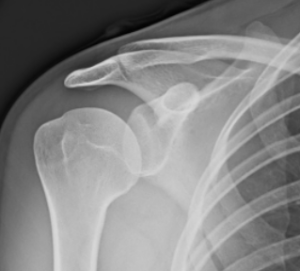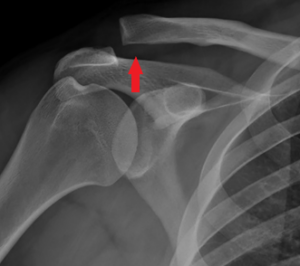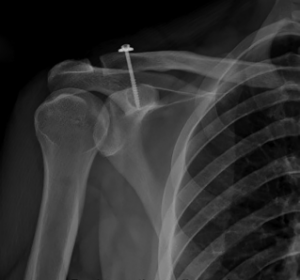Acromioclavicular (AC) Joint Repair and Reconstruction Surgery
Your Diagnosis
AC Joint repair and reconstruction surgery is done to help a person with an AC Joint Sprain. If the AC Joint Sprain injury has occurred recently (within 2-3 weeks), the person may be a candidate for an AC Joint Repair surgery. If the AC Joint Sprain occurred beyond 2-3 weeks in the past, the person may be a candidate for AC Joint Reconstruction surgery.
What happens during Surgery?
Surgery takes between 30 and 45 minutes. It is done with general anesthesia meaning the person is asleep. Also, most of the time the person will have a nerve block in their neck which makes their shoulder and arm numb for 6 to 48 hours.
AC joint repair: In this surgery a screw is placed from the collar bone to the shoulder blade and tightened (see picture). This brings the collar bone back down into its original position. Special very strong thin rope is then used to further secure the collar bone down. If things go well, over the next 6 weeks the body will heal the joint in its natural position.
AC joint reconstruction: For this surgery a cadaver tendon graft (tissue donation from a deceased person) will be used to recreate the torn ligament. The collar bone will be brought back down to its original position and the cadaver graft will be placed through the collar bone and around the shoulder blade. If things go well, over the next 3 months the body will heal the joint in its natural position.
Immediately after Surgery
When the person wakes up from surgery they are usually in the recovery room. After spending one to three hours in the recovery room then the person will get prepared to go home. They will go home in a sling. Since the person will not be allowed to drive or take public transportation home, they will need a ride.
A person may have questions following your surgery. Many of these frequently asked questions about surgery can be answered here.
AC Joint Repair: Removing the hardware after Surgery
6 weeks after a AC repair the screw, washer and rope will need to be removed. After this 20 minutes surgery the person can begin to use their arm right away.
Sometimes a second surgery is needed after a reconstruction of the AC joint to remove the rope.
Therapy after Surgery
Typically after surgery, the person is to rest their arm and take it easy. Gentle motion and stretching is encouraged, but for the most part, the person should be resting, avoid lifting, and avoid putting weight on their arm. People generally do not have to participate in formal therapy. And, their arm should be in a sling. It is common that the person’s shoulder will be stiff after 6 weeks. Sometimes a Manipulation Under Anesthesia is needed.
What to expect after Surgery: week 0 through week 6 (Phase One)
- Pain: Immediately after surgery the person usually has a fair amount of pain. This will be treated with oral pain medications. The pain usually subsides rather quickly and almost all people will stop taking the pain medications by day 5 after surgery. The remaining pain will usually go away over the next 3 months or so.
- Therapy: Most of the time people do not do therapy for the first 6 weeks. They, instead, concentrate on keeping their arm in a sling and not using their shoulder.
- Precautions: The person will be asked to wear a sling and not use their shoulder for the first 6 weeks. The person can use their hand for things such as writing, working a mouse, typing, cutting food, eating, etc. The shoulder should remain relaxed.
- Work: People with desk jobs can go back to work within the week but they should wear a sling. People who have jobs that require lifting things heavier than 5 pounds should remain off work.
What to expect after Surgery: week 6 through week 12 (Phase Two)
- Pain: It is expected that there will be pain with movement of the shoulder. Pain should be much less than during the first few weeks after surgery, and most people are comfortable if they are resting.
- Therapy: Every person at this point is expected to have weakness. Most people are not able to raise their arm to the level of their shoulder. This is completely normal, since the person had been instructed not to use the muscles of their arm. At this point, the person will also begin a light weight, high repetition strengthening exercise program. By 8 to 10 weeks most people are able to raise their arm above their head. A person should not be discouraged if they do not have the strength to do this yet, since everyone progresses differently.
- Precautions: After 6 weeks, the repair surgery should be essentially healed. A person’s restrictions will be lifted. In other words, a person may begin using the shoulder based on “pain and common sense”. If it hurts a little when doing a certain activity, a person may continue doing the activity. If it hurts too much, that’s the body’s way of saying that the person needs to slow down and back off whatever activity they were just attempting. A person should begin activities cautiously and using “common sense”- in other words, if a person wants to try to go swimming, they should try it from the shallow end of a pool (they should not jump into the ocean when the surf is big and the current is strong).
- For people who had a Reconstruction 6 more weeks of rest are needed.
- Work: Most people who have desk jobs are either already back at work or ready to go back to work. Most people who have jobs that require physical labor are not ready to return to work at the 6 week mark. Some may be ready to go back around week 8-10. It’s unlikely that a person who has a highly physical job will go back to full duty at this time.
What to expect after Surgery: week 12 through 1 year and beyond (Phase Three)
People who had the Repair surgery usually feel that their shoulder is near normal between 12 weeks and 1 year: this includes for physical labor and sports.
At 3 months the person who had the Reconstruction surgery is essentially where the person who had the Repair surgery was at 6 weeks (see above): they follow the same protocols. By 4.5 months the person who had the Reconstruction usually feels that their shoulder is near normal: this includes for physical labor and sports.

Normal shoulder

The collar bone is up on the left

AC separation
